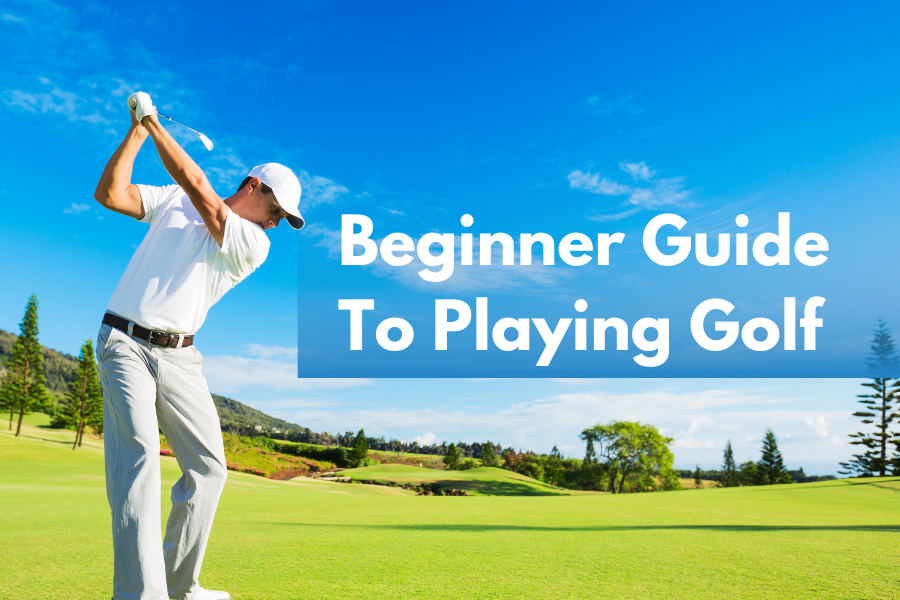In today’s time, golf is the safest, most peaceful, socially distanced outdoor game to play. Even if you are new to it and making mistakes, it’s all right. Every golf player has been a bad golfer once.
When I first started playing golf, I struggled a lot with the right tempo, balance, and especially course pressure. The key is to stay persistent and not give up.
Having gone through the journey myself, I know the problems a beginner player faces. In this article, I am going to walk you through a basic guide on how to get better at golf for beginners.
With that said, let’s start with the basics yet the most effective tips if you are very new to golfing.
The essentials can make you the master
If you are looking forward to being a pro golf player, it is a must to know about the basic of the game. Do not compromise the following fundamentals to hit further goals and make trick shots.
1) Posture and Position
The first thing you need to focus on is a stable stance. If your setup is too wide or too narrow, you will not be able to make a proper swing. You can learn a neutral setup that works most of the time. Once you get the basic positioning, make small changes to it according to your ease.

Here is how you can achieve the perfect posture:
- Keep your legs and back straight.
- Keep the feet roughly shoulder width apart and balance your weight equally on both legs.
- Hold the club in front.
- Tilt your hips and slightly bend your back.
- Do not twist your arms.
- Tilt your head toward the target.
- Hit the ball while maintaining a straight back.
Though this positioning can seem difficult and uncomfortable initially, you will get the hang of it over time. Good posture enables you to make the perfect swing every time, preventing muscle pulls and back pain.
Check out this quick video by Pete Styles on perfect Golf Posture.
After maintaining a proper stance, work on your grip. Having a weak grip can make golf a game of compensation. Once you master a strong grip, tune it with your swing. Make sure that you are not creating bad or too many angles.
2) Tuning up your tempo

From my experience, a smooth tempo is the most important part of mastering the game. Whether your swing speed is high or low, a proper 3:1 tempo of the backswing to downswing can be a game-changing factor.
Every great player has a different stance and grip, but what they have in common is the smooth tempo rhythm. Here is a step-by-step guide to a stable tempo.
- Take a deep breath and loosen the tension built up in your muscles.
- Maintain the right grip pressure according to the type of shot you are making.
- Making a loose grip initially is advisable.
- Tighten your grip when you’re about to go for the backswing.
- Make a slow and smooth takeaway.
Building some momentum with the backswing helps you transition smoothly to the downswing. Smooth tempo is what separates pros from amateurs.
3) Make a pre-shot routine

All pro golf players have a pre-shot routine to kick-start their game. Every routine is different from the others, but none is wrong. In golf, you can imitate your idols until you get to the core of their strategies.
Well, the good news is that you can also have your own pre-shot routine. I will walk you through the steps of setting up a pre-shot routine.
- Once you have put your gloves on, start.
- Strategize your shot; calculate the distance, which club to use, the intended result, and the risks to evade.
- Pick a long-distance target and an intermediary one just some inches ahead of your ball. This will aid you in lining up the ball.
- Visualize your swing.
- Take some smooth practice swings to maintain a stable tempo.
- Execute the perfect shot.
Remember that these are practice shots; even if you miss a few shots, you are missing them to learn. Accept the outcome and move on. Practice makes the man perfect!
4) Know your Driver, Putter, and Wedges
Knowing your clubs is a great way to get better at this game.

Mastering a driver can be tricky for beginners because of its low loft, but once you learn to cover the distance, you will get the hang of it. You can opt for a higher loft and a flexible shaft.
Most players focus on their driver so much that they neglect their putter. Putters are of prime importance in your gear. Analyze which putter to use. Putting can improve your score and save the day when your swing is off.
If you are serious about how to get better at golf for beginners and want to play on a higher level, master your wedges. If you know how and when to use a sand wedge, a pitching wedge, a gap wedge, and a lob wedge, you are way ahead of the others.
5) Practice makes perfect

Golf is not unlike other sports when it comes to practice. The more you play, the better you play.
Beginners tend to take bad shots too seriously. If you hit some really bad shots at the start, it’s all right to feel bad, but you should not take it too personally. Laugh it off and prepare for the next one. The goal is not to repeat your swing mistakes and keep practicing.
Practice excessively on the range. It takes your mind off unnecessary stuff and helps you focus on your fundamentals. Yet, you will face difficulties executing the same swing when you come from range to course. The key is to spend more time on the course. Practice your short game, run around with your friends, analyze the course, and get familiar with it. If you are a busy person, set up a schedule to hit the course two to three times a week regularly.
Learn by observing your fellow players and watching their strategies. Sometimes, players are happy to share their acumens with you. It is a great way to become familiar with diverse approaches.
The right equipment can uplift your game

One of the biggest mistakes golf players make is playing with the wrong equipment. If you are starting off with a challenging club, it will maximize the chance of you screwing up. Let’s talk about which equipment you would require as a beginner to get on the course.
Talking about golf equipment, there are not many pieces to collect. Apart from the subsidiary stuff, you just need to have the right clubs and balls. However, their selection is a task.
– Golf Clubs
According to USGA, each player can carry a maximum of 14 clubs with him. As a beginner, you will not require these many clubs. The more clubs you have, the trickier it will get to pick the right one. You need less, not more.
Get yourself a driver, a putter, and a selection of irons and hybrids. Before you get any club, check its grip, shaft, hosel, and club head.
– Drivers
A driver, or a “1 wood,” helps you hit farther distances with a single swing. You just need one of these in your bag. You can choose from a variety of lofts. A loft decides how far the ball goes and its trajectory. The higher the loft, the more trajectory your ball will cover and reach a long distance. If you use a low loft, your ball will not cover much. Beginners struggle with their swing speed, so it is better to use a high loft driver.
– Putters
A putter is the most important club for a beginner. It helps you “put” the ball in the hole on the greens. You can choose from a variety of blade putters, mallet putters, and traditional putters. Mallet putters are usually the most forgiving ones and suit beginners.
– Irons
An iron can be used to hit about any shot on a course. They generally have shorter shafts and cover different distances. Making the most of the clubs in a golfers bag, irons range from 2 to 9-iron. Higher irons cover less distance, while lower ones cover more. A 4-5 iron is best for a beginner.
– Golf Balls

Having picked the right clubs, the next step is to choose the right ball. However, it is not as easy as it sounds. Unlike other sports, where you have to buy one type of ball, golf equipment companies have released several different types of golf balls. This endless selection makes choosing a lot harder.
As a beginner, you will certainly miss more than you hit. This means losing a lot of balls. So make sure that it doesn’t cost you a fortune. Opt for balls that are not too expensive, keeping in mind that cheaper balls can make your game much more challenging. You have to settle somewhere in between.
Picking the right ball helps you control your spin, maximum ball flight, correct swing speed, and tailor specific shots and distances. To say the least, the right ball makes the game relatively easier.
– Gloves
Holding the club grip for a longer period of time can cause sores or blisters on your skin. To maintain focus, golf players choose comfortable gloves. However, keep in mind that golf gloves are usually worn as a sole rather than in pairs.
If you are a right-handed person, you will wear the glove on your left hand, the lead hand. Since the lead hand controls the swing motion and spin, it is more likely to get bruised. Players like to keep the dominant hand bare to have a firm hold on the club. But you can wear a pair too; there are no strict rules about that.
– Golf shoes
As a beginner, you can play in regular sneakers just fine. However, when you start taking the game more seriously, it is wise to invest in a good pair of golf shoes. They increase traction and help in a more stable and smooth swing. Even if they do not affect your game much, walking 18 holes comfortably is worth the money.
👟 Check Out Recommended List Of Best Waterproof Spikeless Golf Shoes
– Towel
Keeping a clean towel with you comes in handy while cleaning your club off the dirt and grass from the course. If you are not planning on investing in it, snip it from your golfer friend’s cupboard.
8 tips on how to get better at golf – Which helped me personally

1- Take lessons
This is uncompromising if you are damn serious to quickly amp up your game. Get the right coach or just learn from the YouTube playlist – learning is the key.
If you keep missing shots and your game is not moving forward, it may be because you just dived into the course without learning the basic etiquette and mechanics of the game.
One way to get better at golf is to take lessons. Taking lessons is as important as investing in good quality equipment. Rather than going on buying more and heftier equipment, spending money on taking lessons can pay great dividends. Once you find a coach you like, stick with them.
2- Make chip shots
Before heading towards longer pitch shots, start by making small chip shots. When you are near the green and do not need to carry the ball, practicing your swing by making low-trajectory chip shots is better.
3- Get club-fitting
If you are still playing with the clubs you started with and not getting anywhere, instead of wondering how to get better at golf as a beginner, I urge you to get club-fitted. Club-fitting can change your golf game entirely.
I did not realize that my irons were holding me back until I decided to find new gear. If you cannot consult an expert but are eager to know about how to get better at golf for beginners, do your research and rent some clubs for a week or two. Once you start practicing with new and diverse clubs, you will realize how better you can get just by changing your gear.
4- Aim right
Another common mistake beginners make is aiming for the flag instead of the center of the green. Keep your focus on both the ball and the target. Do not neglect one while focusing on the other.

A simple trick to keep your targets lined up is to pick an intermediate target between the ball and the hole. Aim the clubface at your ball in line with your target.
5- Use a Tee
There is absolutely no shame in using a tee. Using a tee makes it a lot easier to hit the ball in the direction of your target. Although there is no hard and fast rule about their use, they are cheap and easily accessible. They benefit the span, control, and precision of your shot.
6- Remember, it’s also a mind game
Golf is a blend of your athletic abilities and your mental capacities. You spend hours on the course hitting the ball for a few minutes only. It’s mostly about strategy and technique. We know that it can get frustrating, but the key is to stay calm and not lose focus.
7- Focus on the hits, forget the misses
Bad shots are normal. Everybody makes them. The moment you start focusing on the misses is the moment you start going downhill. Accept the blunders, keep your head up, and move on.
8- Have fun
We know that golf can be stressful. Even when it gets too competitive, remember that it is just a game. You took time out of your busy schedule to enjoy yourself and have fun. Even if you don’t score well, maintain a positive attitude. A positive attitude favors learning, and your peers will be happy with you too.
Get swinging and dominate the greens!

At last, I would say that Golf is a game with many rules and techniques. You can master some, but not all. I can tell you a hundred more tips, but none can ensure a perfect shot every time you swing your club. Somedays, you will be in your best form; some days, you will score your worst shots. Even the best players in the world make mistakes. It’s just this wild game of golf.
I hope your query about how to get better at golf for beginners has been solved. You’re not playing it wrong as long as you’re being respectful to the game and other players. Play with your friends, involve your kids, and have fun!
It’s your turn to take those swings and show the greens who’s boss!
️⛳️ More Recommended Reads For Beginners:
- What is Executive Golf Course?
- What to wear for golf men
- Guide: Beginner casual golf attire for ladies
- What to wear golfing if you don’t have golf clothes?
- What shoes to wear for golf? (Detailed)
- 9 Most comfortable golf shoes for men
- Are running shoes for golf appropriate?
- Do you wear golf shoes to the driving range?
Frequently Asked Questions
Where Should I Practice My Game?
A driving range is a great place to practice your swings. You can practice all sorts of shots here and learn fundamentals before getting to an actual course. If you’re new to golf, practicing at a range near your place with your friends would be the best way to get a good grip on stance, posture, tempo, and swing.
How do I break 80 every time?
Breaking 80 is difficult but not impossible. Here’s how you can do it:
- Do not waste strokes. Avoid hitting in risk areas, past bounds, and an “unplayable lie.”
- Make your short game your weapon. Breaking 80 is almost unmanageable if you have 36+ putts. Practice pushing this number down nearer to 30. Chip the ball closer to the hole.
- Learn to keep your bad shots less bad. Breaking 80 is about playing your misses.
- Save bogies. When you are trying to break 80, double or triple bogeys can destroy your round.
Do I need lessons first?
If you are serious about the game and want to learn how to get better at golf, it’s better to take lessons initially. Knowing your form, swing, and stance beforehand helps you become a better golfer sooner.
Why is golf so hard for beginners?
Golf is a difficult game. Especially if you’re new to it, it can be mentally challenging and physically draining. Correct equipment choice followed by hours of an 18-hole round looks a lot to a beginner. Managing strategy, smooth swing, and contemplating other physics of the game can be challenging.
How long does it take a beginner to get good at golf?
If you think that you will take a couple of lessons, practice for a couple of weeks, and get good at golf, you are deluded. It takes almost six months for a beginner to master hitting the ball correctly. Getting good at the game is a whole other thing. If you play to score, you might lack learning. Play to enjoy the game and stay positive.
What are the three most important skills in golf?
Although there are a number of skill sets to master golf, the top three would be pre-shot fundamentals, club face control, and maintaining the 3:1 tempo.
How often should a beginner play golf?
As much as he can. The more, the better. Remember that every minute spent on the course is worth something. However, if you have a tight schedule, try to be on course at least three times a week. It may not be for long periods of time; half an hour of mindful putting and chipping will serve the purpose. Just stay consistent.
What are three good golf tips for beginners?
- Pick the right equipment – if your gear is not best suited for you, it’s holding you back.
- Get a coach – getting lessons from the start is better than playing off blindly and adopting bad techniques.
- Keep practicing: If you leave practicing for some time, you will likely forget the system.
A guy with a charming face following his passion (both Golf and Blog) from Kansas. Bryan is the writer and creator of IAmLearningHowToGolf.com, loves golf, but he didn’t start playing until he was in his 20s. He’s not a pro by any means, but he’s put in the time and effort to get pretty darn good. Bryan’s main goal with this blog is to help other golfers improve their game and have more fun on the course. He does this by writing informative, relatable, and down-to-earth content. When he’s not golfing or writing, Bryan enjoys going on hikes, spending time with his family, and watching movies sometimes. For any queries reach out to him at Bryan@iamlearninghowtogolf.com.

